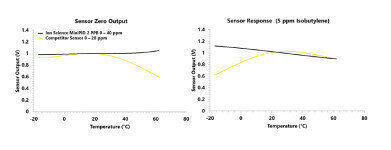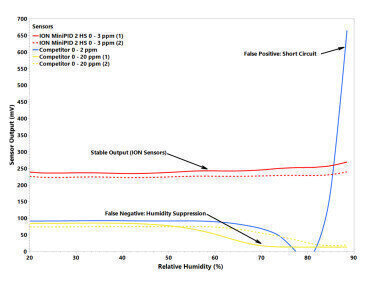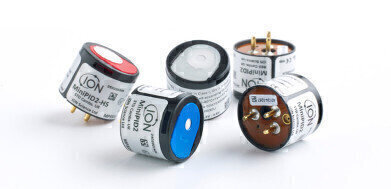-

-
 Figure 2. Ion Science’s MiniPID 2 PPB sensor temperature stability versus competitor (temperature normalised to 20.5°C). Left: Ion Science’s sensor zero output over temperature is extremely stable. Right: Ion Science’s sensor is much stabler than competitors’ response to VOC over temperature
Figure 2. Ion Science’s MiniPID 2 PPB sensor temperature stability versus competitor (temperature normalised to 20.5°C). Left: Ion Science’s sensor zero output over temperature is extremely stable. Right: Ion Science’s sensor is much stabler than competitors’ response to VOC over temperature -
 Figure 1. ION Science’s MiniPID 2 HS and competitors’ sensor response to 200 ppb isobutylene with increasing relative humidity @ 20°C. Competitor sensors suffer from false negatives above 55% RH and false positives above 90% RH. ION sciences sensors remain stable throughout.
Figure 1. ION Science’s MiniPID 2 HS and competitors’ sensor response to 200 ppb isobutylene with increasing relative humidity @ 20°C. Competitor sensors suffer from false negatives above 55% RH and false positives above 90% RH. ION sciences sensors remain stable throughout. -

-

Gas Detection
It has always been ION Inside
Jan 21 2022
ION Science’s unique technology has always been inside MiniPID sensors available from ION Science and their only authorised distributor, Alphasense Ltd. Following the purchase of Alphasense by AMETEK Inc. late last year, this long-term successful relationship has now come to an end.
Customers who were purchasing MiniPID sensors (PID-A1, PID-AH and PID-AX) through Alphasense or their distributors are now encouraged to source the world’s best PID sensor directly from ION Science, their partners and authorised dealers. ION Science has worked hard with its committed suppliers to offer the best PID sensor lead times on the market. Coupled with its experienced and dedicated support teams, ION will make sure continued supply of MiniPID is seamless.
ION Science is available to support customers with any question about the transition away from Alphasense supply, and they can be assured there is no change in product quality, choice, or availability. The technology that sets the ION Science MiniPID sensors apart remains, delivering the same excellent product as always.
ION and world leading PID technology
ION Science, with headquarters based in a state-of-the-art, purpose-built facility near Cambridge, was founded in 1989 and has a strong track record of developing award winning innovative gas sensors and instrumentation driven by market needs. Specialising in photoionisation detection (PID), ION work closely with end users to understand their requirements and ensure the voice of the customer is represented in all product developments.
This focus helped highlight major issues posed when using PID to measure VOCs in high humidity environments, putting ION on the path to developing world leading novel solutions to overcome them.
Humidity can affect PID measurements in two ways:
False positives as humidity increases, due to shorting between sensing electrodes
False negatives as humidity increases, due to water vapour adsorbing UV light instead of ionising target gas
To eliminate false positives, ION developed a patented fence electrode that guards the sensing electrodes against short circuits, with false negatives being minimised through a combination of advanced electrode geometry and moisture filtering. These designs feature in all ION’s sensors and instrumentation and are essential in providing accurate measurements throughout the wide range of environments PID are used in.
Figure 1. ION Science’s MiniPID 2 HS and competitors’ sensor response to 200 ppb isobutylene with increasing relative humidity @ 20°C. Competitor sensors suffer from false negatives above 55% RH and false positives above 90% RH. ION sciences sensors remain stable throughout.
Other key considerations in sensor design are temperature stability and diagnostics. Ion developed an application specific integrated circuit (ASIC) which monitors the sensors performance and feeds back to provide market leading temperature stability.
Figure 2. Ion Science’s MiniPID 2 PPB sensor temperature stability versus competitor (temperature normalised to 20.5°C). Left: Ion Science’s sensor zero output over temperature is extremely stable. Right: Ion Science’s sensor is much stabler than competitors’ response to VOC over temperature
The ASIC also performs key diagnostic duties which flag when the lamp is out and if the ionisation chamber is compromised. Without these, the user has no way to know if of the sensor has been compromised and potentially leaves the user at risk to dangerous exposures. Ion Science’s sensor are the only fail safe PIDs in the world.
Choosing the right sensor and supplier
The applications for PID are extremely varied and demand detection of different chemicals in a wide range of concentrations and operating environments. ION Science’s committed research and development team, with over 60 years of PID expertise, have worked tirelessly with end users and product management teams to create the world’s most comprehensive PID sensor portfolio. This includes having the only 11.7 eV sensor on the market, helping their partners detect critical chemicals including formaldehyde, methanol and ethylene, and also the most sensitive PID in the world, MiniPID 2 HS.
Using the best technology is fundamental when designing a product; however, technical support, quality and reliable supply are critical for long term success. ION Science treat its customers as partners and works closely with major gas detection companies across the world. Integrating PIDs into an instrument is more challenging than with other sensors. ION has over twenty-five years’ experience in developing VOC instrumentation, giving them a deep understanding of all the issues involved. Their enthusiastic support team enjoy sharing this knowledge to decrease product development times and speed up the return on investment for our partners.
At the heart of any PID is the ionising source, the lamp, which defines lifetime, sensitivity, ionisation energy and sensor quality. As the lamp is such a critical component, ION Science began manufacturing them in house over twenty years ago and have invested significantly in cutting edge technology to continuously improve processes, now boast the longest lifetime and highest quality lamps on the market.
In the ever-challenging global supply chain landscape, ION has worked closely with all its key suppliers to ensure long term uninterrupted supply. This allows them to provide the best PID sensor lead times to all their partners globally.
Future
With their customer base growing and opportunities for new products increasing, ION Science have started construction of a new dedicated research and development facility at their Cambridgeshire headquarters. The team look forward to addressing future sensing needs including, miniaturisation, reducing power consumption and more selective VOC measurement.
The future direction of ION is clearly reflected in its Vision, Mission and Proposition, in support of its key stakeholders:
VISION
To protect lives and preserve the environment.
MISSION
To be the leader in gas sensing technology with relationships built on trust, pioneering products, responsiveness,and exceptional customer service.
PROPOSITION
Pioneering Gas Sensing Technology.
Digital Edition
IET 34.2 March 2024
April 2024
Gas Detection - Biogas batch fermentation system for laboratory use with automatic gas analysis in real time Water/Wastewater - Upcycling sensors for sustainable nature management - Prist...
View all digital editions
Events
Apr 22 2024 Hannover, Germany
Apr 22 2024 Marrakech, Morroco
Apr 23 2024 Kuala Lumpur, Malaysia
Apr 23 2024 Kintex, South Korea
Apr 23 2024 Edmonton, AB, Canada

















